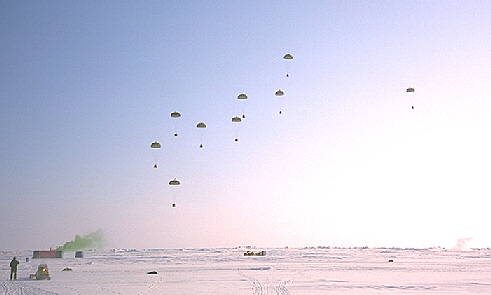Arctic Ice Camp Operations
After World War II, the USAF continued surveillance of the deep Arctic regions using converted B-29 Superfortresses to report the existing meteorological conditions. In 1946, T- 1 became the first ice island identified by the Air Force. However, it was not until January, 1952 that "Project Icicle" was formed to establish a weather-reporting station and geophysical research base on the T-3 ice island, for the Air Weather Service (AWS). At the time, AWS was aquiring meteorological measurements to determine the general circulation of the earth's atmosphere, and the jet stream. Data that was collected on T-3 included: ice island drift, atmospheric pressure, temperature, humidity, and wind velocites on the surface, and temperature, salinity, biomass, and bottom samples from beneath the ice. Ice cores that were taken from the ice island, were examined for their presence of debris. In order to acquire this data over time, resources of the USAF were required to outfit, man and resupply this post for months.
Air-supported field expeditions are still required in order to obtain all the information that we can from the deep Arctic. Those from recent years (e.g. AIDJEX, CEAREX) often have the same logistics concerns and require similar resources as the earliest ones. Relatively small, short duration ice camps employ manpower and supply resources more efficiently, but leave little time for data acquisition. However, when the ice camps are used as platforms to deploy other instruments to remain for extended durations, then these expeditions become more resource effective; especially when each instrument carries multiple sensors.
With this in mind, we have endeavored to develop an effective ice-ocean research platform that would provide the opportunity to understand the short (hourly and daily), seasonal and inter-annual rates of change in sea-ice and their relationship to local and regional meteorology, upper ocean physics, primary production and, finally, to the process and the rate of biogeochemical cycles in the Polar ocean. In order to be useful to all disciplines of the international scientific community, the gathered data must be transmitted in real time.
